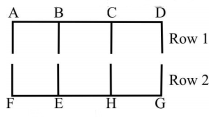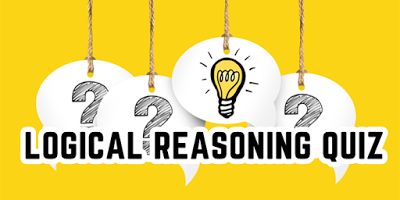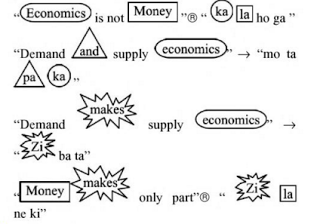Hello and welcome to ExamPundit. Here is a set of Reasoning Quiz for IRDAI Junior Officer.
Direction (Q 1-5) : Study
the information and answer the following questions.
the information and answer the following questions.
In a certain code language ‘economics is not money’ is
written as, ‘ka la ho ga’, ‘demand and supply economics’ is written as, ‘mo ta
pa ka’, ‘money makes only part’ is written as, ‘zi la ne ki’ ‘demand makes
supply economics’ is written as, ‘zi mo ka ta’.
written as, ‘ka la ho ga’, ‘demand and supply economics’ is written as, ‘mo ta
pa ka’, ‘money makes only part’ is written as, ‘zi la ne ki’ ‘demand makes
supply economics’ is written as, ‘zi mo ka ta’.
1. What is the code
for ‘money’ in the given code language?
for ‘money’ in the given code language?
1) ga
2) mo
3) pa
4) ta
5) la
2. What is the code
for ‘supply’ in the given code language?
for ‘supply’ in the given code language?
1) only ta
2) only mo
3) either pa or mo
4) only pa
5) either mo or ta
3. What may be the
possible code for ‘demand only more’ in the given code language ?
possible code for ‘demand only more’ in the given code language ?
1) xi ne mo
2) mo zi ne
3) ki ne mo
4) mo zi ki
5) xi ka ta
4. What may be the
possible code for ‘work and money’ in the given code language?
possible code for ‘work and money’ in the given code language?
1) pa ga la
2) pa la tu
3) mo la pa
4) tu la ga
5) pa la ne
5. What is the code
for ‘makes’ in the given code language?
for ‘makes’ in the given code language?
1) mo
2) pa
3) ne
4) zi
5) ho
Directions (Q. 6-10):
Study the following information to answer the given questions:
Study the following information to answer the given questions:
Eight people are sitting in two
parallel rows containing four people each, in such a way that there is an equal
distance between adjacent persons. In row 1, A, B, C and D are sitting (but not
necessarily in the same order) and all of them are facing south. In row 2, E,
F, G and H are sitting (but not necessarily in the same order) and all of them
are facing north. Therefore, in the given seating arrangement each member
sitting in a row faces another member of the other row. G sits second to the
right of E. The one who faces E sits to the immediate right of C. A faces the
immediate neighbour of E. H sits to immediate left of the person who faces D. H
does not sit at an extreme end of the line.
parallel rows containing four people each, in such a way that there is an equal
distance between adjacent persons. In row 1, A, B, C and D are sitting (but not
necessarily in the same order) and all of them are facing south. In row 2, E,
F, G and H are sitting (but not necessarily in the same order) and all of them
are facing north. Therefore, in the given seating arrangement each member
sitting in a row faces another member of the other row. G sits second to the
right of E. The one who faces E sits to the immediate right of C. A faces the
immediate neighbour of E. H sits to immediate left of the person who faces D. H
does not sit at an extreme end of the line.
6. Who amongst the
following faces A?
following faces A?
1) E
2) F
3) G
4) H
5) Cannot be determined
7. Who amongst the
following faces the person who sits exactly between G and E?
following faces the person who sits exactly between G and E?
1) A
2) B
3) C
4) D
5) Cannot be determined
8. Who amongst the
following faces G?
following faces G?
1) A
2) B
3) C
4) D
5) Cannot be determined
9. Which of the
following is true regarding B?
following is true regarding B?
1) B sits exactly between C and D.
2) D sits second to the right of B.
3) B sits at an extreme end of the line.
4) B is an immediate neighbour of the person who faces F.
5) None is true
10. Four of the
following five are alike in a certain way based on the given seating
arrangement and thus form a group.
Which is the one that does not belong to that group?
following five are alike in a certain way based on the given seating
arrangement and thus form a group.
Which is the one that does not belong to that group?
1) E
2) D
3) F
4) G
5) A
| Solutions – | ||
|---|---|---|
 |
||
Regards
function answer(id){
if(document.getElementById(id).style.display == “block”){
document.getElementById(id).style.display = “none”;
}else{
document.getElementById(id).style.display = “block”;
}
}
#a1{display:none;}
#a2{display:none;}
Team ExamPundit
Sponsored
(adsbygoogle = window.adsbygoogle || []).push({});




